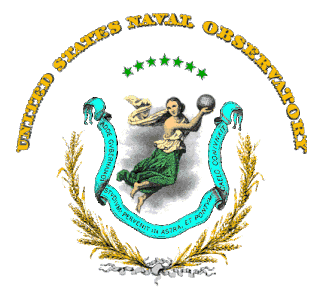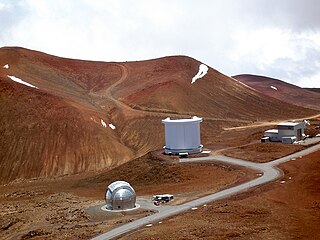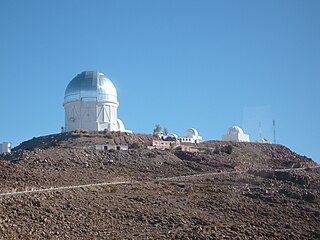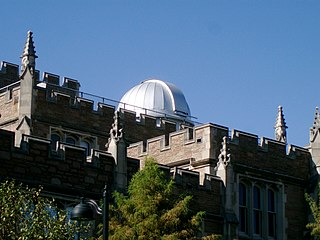Related Research Articles

The United States Naval Observatory (USNO) is one of the oldest scientific agencies in the United States, with a primary mission to produce Positioning, Navigation and Timing (PNT) for the United States Navy and the United States Department of Defense. Located in Northwest Washington, D.C. at the Northwestern end of Embassy Row, it is one of the pre-1900 astronomical observatories located in an urban area; at the time of its construction, it was far from the light pollution thrown off by the (then-smaller) city center. Former USNO director Gernot M. R. Winkler initiated the "Master Clock" service that the USNO still operates, and which provides precise time to the GPS satellite constellation run by the United States Air Force. The USNO performs radio VLBI-based positions of quasars with numerous global collaborators, in order to produce Earth Orientation parameters.

The Royal Observatory, Greenwich is an observatory situated on a hill in Greenwich Park, overlooking the River Thames. It played a major role in the history of astronomy and navigation, and because the prime meridian passes through it, it gave its name to Greenwich Mean Time. The ROG has the IAU observatory code of 000, the first in the list. ROG, the National Maritime Museum, the Queen's House and Cutty Sark are collectively designated Royal Museums Greenwich.

Subaru Telescope is the 8.2-meter (320 in) flagship telescope of the National Astronomical Observatory of Japan, located at the Mauna Kea Observatory on Hawaii. It is named after the open star cluster known in English as the Pleiades. It had the largest monolithic primary mirror in the world from its commission until 2005.

Yerkes Observatory is an astronomical observatory in Williams Bay, Wisconsin owned by the University of Chicago Department of Astronomy and Astrophysics. The observatory, sometimes called "the birthplace of modern astrophysics", was founded in 1897 by astronomer George Ellery Hale and financed by businessman Charles T. Yerkes. It represented a shift in the thinking about observatories, from their being mere housing for telescopes and observers, to the early-20th-century concept of observation equipment integrated with laboratory space for physics and chemistry. The observatory ceased operations in 2018.

The Mauna Kea Observatories (MKO) are a number of independent astronomical research facilities and large telescope observatories that are located at the summit of Mauna Kea on the Big Island of Hawaiʻi, United States. The facilities are located in a 525-acre (212 ha) special land use zone known as the "Astronomy Precinct", which is located within the 11,228-acre (4,544 ha) Mauna Kea Science Reserve. The Astronomy Precinct was established in 1967 and is located on land protected by the Historical Preservation Act for its significance to Hawaiian culture.

The McDonald Observatory is an astronomical observatory located near the unincorporated community of Fort Davis in Jeff Davis County, Texas, United States. The facility is located on Mount Locke in the Davis Mountains of West Texas, with additional facilities on Mount Fowlkes, approximately 1.3 kilometers (0.81 mi) to the northeast. The observatory is part of the University of Texas at Austin. It is an organized research unit of the College of Natural Sciences.

The Cerro Tololo Inter-American Observatory (CTIO) is an astronomical observatory located on Cerro Tololo in the Coquimbo Region of northern Chile, with additional facilities located on Cerro Pachón about 10 kilometres (6.2 mi) to the southeast. It is within the Coquimbo Region and approximately 80 kilometres (50 mi) east of La Serena, where support facilities are located. The site was identified by a team of scientists from Chile and the United States in 1959, and it was selected in 1962. Construction began in 1963 and regular astronomical observations commenced in 1965. Construction of large buildings on Cerro Tololo ended with the completion of the Víctor Blanco Telescope in 1974, but smaller facilities have been built since then. Cerro Pachón is still under development, with two large telescopes inaugurated since 2000, and one in the early stages of construction.

The National Astronomical Observatory of Japan (NAOJ) is an astronomical research organisation comprising several facilities in Japan, as well as an observatory in Hawaii. It was established in 1988 as an amalgamation of three existing research organizations - the Tokyo Astronomical Observatory of the University of Tokyo, International Latitude Observatory of Mizusawa, and a part of Research Institute of Atmospherics of Nagoya University.

The Harvard–Smithsonian Center for Astrophysics (CfA) is a research institute which carries out a broad program of research in astronomy, astrophysics, earth and space sciences, and science education. The center's mission is to advance knowledge and understanding of the universe through research and education in astronomy and astrophysics.

The Hat Creek Radio Observatory (HCRO) is operated by SRI International in the Western United States. The observatory is home to the Allen Telescope Array designed and owned by the SETI Institute in Mountain View, CA.

The Vassar College Observatory is an astronomical observatory of the private Vassar College, located near the eastern edge of the Poughkeepsie, New York college's campus. Finished in 1865, it was the first building on the college's campus, older even than the Main Building, with which it shares the status of National Historic Landmark. The observatory's significance is due to its association with Maria Mitchell, the first widely known woman astronomer in the United States.

Mount Laguna Observatory (MLO) is an astronomical observatory owned and operated by San Diego State University (SDSU). The telescope was operated in partnership with the University of Illinois at Urbana-Champaign (UIUC) until 2000. MLO is located approximately 75 kilometers (47 mi) east of downtown San Diego, California (USA) on the eastern edge of the Cleveland National Forest in the Laguna Mountains and near the hamlet of Mount Laguna. MLO was dedicated on June 19, 1968, seven years after SDSU's Department of Astronomy became an independent academic department of SDSU's College of Sciences. The dedication took place during the 1968 summer meeting of the Astronomical Society of the Pacific. Currently SDSU is working with University of Kansas (KU), and UNC Chapel Hill on various projects.

The Warner and Swasey Observatory is the astronomical observatory of Case Western Reserve University. Named after Worcester R. Warner and Ambrose Swasey, who built it at the beginning of the 20th century, it was initially located on Taylor Road in East Cleveland, Ohio, USA. The observatory, which at that time housed a 9.5-inch (24 cm) refractor, was donated in 1919 to the Case School of Applied Science. The newer 24-inch (61 cm) Burrell Schmidt telescope was built in 1939.

Las Campanas Observatory (LCO) is an astronomical observatory owned and operated by the Carnegie Institution for Science (CIS). It is in the southern Atacama Desert of Chile in the Atacama Region approximately 100 kilometres (62 mi) northeast of the city of La Serena. The LCO telescopes and other facilities are near the north end of a 7 km (4.3 mi) long mountain ridge. Cerro Las Campanas, near the southern end and over 2,500 m (8,200 ft) high, is the future home of the Giant Magellan Telescope.

Anderson Mesa Station is an astronomical observatory established in 1959 as a dark-sky observing site for Lowell Observatory. It is located at Anderson Mesa in Coconino County, Arizona (USA), about 12 miles southeast of Lowell's main campus on Mars Hill in Flagstaff, Arizona.

The Sydney Observatory is a heritage-listed meteorological station, astronomical observatory, function venue, science museum, and education facility located on Observatory Hill at Upper Fort Street, in the inner city Sydney suburb of Millers Point in the City of Sydney local government area of New South Wales, Australia. It was designed by William Weaver (plans) and Alexander Dawson (supervision) and built from 1857 to 1859 by Charles Bingemann & Ebenezer Dewar. It is also known as The Sydney Observatory; Observatory; Fort Phillip; Windmill Hill; and Flagstaff Hill. It was added to the New South Wales State Heritage Register on 22 December 2000.

Crow Observatory is a historic observatory housed in Crow Hall on the Danforth Campus of Washington University in St. Louis. The historic telescope is still in use, and the observatory is open to the public.

The Kenwood Astrophysical Observatory was the personal observatory of George Ellery Hale, constructed by his father, William E. Hale, in 1890 at the family home in the Kenwood section of Chicago. It was here that the spectroheliograph, which Hale had invented while attending MIT, was first put to practical use; and it was here that Hale established the Astrophysical Journal. Kenwood's principal instrument was a twelve-inch refractor, which was used in conjunction with a Rowland grating as part of the spectroheliograph. Hale hired Ferdinand Ellerman as an assistant; years later, the two would work together again at the Mount Wilson Observatory.

The Lulin Observatory is an astronomical observatory operated by the Institute of Astronomy, National Central University in Taiwan.

The Meade LX200 is a family of commercial telescopes produced by Meade Instruments launched in 1992 with 8" (20.32 cm) and a 10" (25.4 cm) Schmidt–Cassegrain models on computerized altazimuth mounts. Two larger models, a 12" (30.48 cm) and a 16" (40.64 cm), quickly followed. The original version was later informally named the "classic" LX200 as newer upgraded versions replaced it. The first of these was the LX200GPS, which featured global positioning system electronics. A 360 mm (14 in) LX200GPS was later added to the line.
References
- ↑ "BSUO (Ball State University Observatory)". Archived from the original on 2007-09-27. Retrieved 2007-06-09.